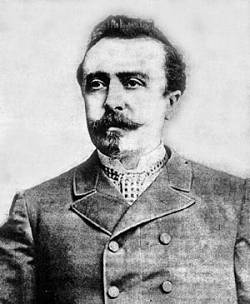 A portrait of Charles Joseph Van Depoele taken in 1887 just prior to his departure from Chicago to work for Thomson-Houston at Lynn, Massachusetts.
A portrait of Charles Joseph Van Depoele taken in 1887 just prior to his departure from Chicago to work for Thomson-Houston at Lynn, Massachusetts.
|
Charles J. Van Depoele
By John Prentice |
 A portrait of Charles Joseph Van Depoele taken in 1887 just prior to his departure from Chicago to work for Thomson-Houston at Lynn, Massachusetts.
A portrait of Charles Joseph Van Depoele taken in 1887 just prior to his departure from Chicago to work for Thomson-Houston at Lynn, Massachusetts.
It is often difficult to decide who actually invented a thing, particularly so in the field of electric traction. One pioneer who is often overlooked is Charles J. Van Depoele. His inventive thinking was way ahead of his rivals and in so many ways contributed to the development of the electric tramway.
On 31st May 1879, Dr. Werner von Siemens demonstrated a small passenger carrying vehicle at the Berlin Trades Exhibition. It was electrically driven from a third rail supply and carried over 80,000 passengers in a few months. The Siemens and Halske company went on to open on 12th May 1881 the world's first true electric tramway, from the Anhalt railway station in Lichterfelde, near Berlin, to the Cadet School 1.5 miles away. It was metre gauge and used two rail current supply at 180 volts.
The electric tramway idea was then largely advanced in the United States, later being re-imported into Europe. One early inventor was Leo Daft, an Englishman living in Jersey City, New Jersey, who from 1883 experimented with electric locomotives and in 1885 started to operate a service pulling horse cars on the tramway in Baltimore, using a third rail system at 120 volts. By 1887 Daft had opened further systems in several Connecticut cities and Orange, New Jersey but was using electrified horse cars with a small 4-wheel "troller" or "trolley" (possibly the origin of the name trolley-car) running on the top of two overhead wires for current supply.
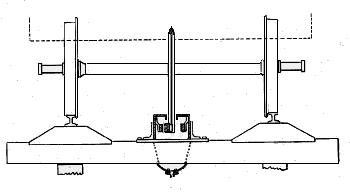 An extract from US patent number 285,858 of 1883 shows Van Depoele's design for a conduit current system. It was possibly the system used in that year to supply Van Depoele's demonstration car at the Chicago Inter-state Fair and was certainly that used on his short line at the Toronto Annual Exposition in 1884.
An extract from US patent number 285,858 of 1883 shows Van Depoele's design for a conduit current system. It was possibly the system used in that year to supply Van Depoele's demonstration car at the Chicago Inter-state Fair and was certainly that used on his short line at the Toronto Annual Exposition in 1884.
Another gentleman to use a converted horse car fitted with a dynamo and an over-running troller was John C. Henry, who at the end of 1884 operated this car in Kansas City. Meanwhile in Ohio in the same year, Edward M. Bentley and Walter H. Knight were electrifying the East Cleveland Street Railway on their conduit current collection system. Also using conduit, Professor Sidney H. Short and John W. Nesmith ran an experimental line on the campus of Denver University in 1885, which was then operated on the city streets in 1886/7. This was the same Short-Nesmith "Series Electric Traction System" which was tried experimentally at Gravesend in the UK in 1889/90. But most of these early experiments were preceded by patented designs by Charles J. Van Depoele.
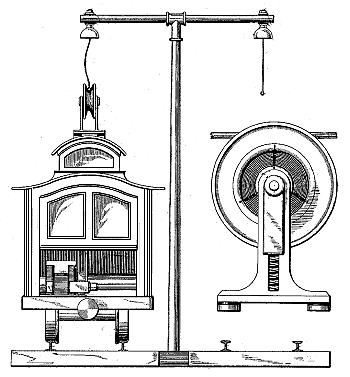 US Patent 331,585 of 1885 is the first to show an under-running trolley system. The wheel was sprung vertically to press against the under side of the suspended conductor wire. (On the right - enlarged side view of the wheel). Van Depoele used a similar system on his mile long line at the Toronto Annual Exposition in 1885.
US Patent 331,585 of 1885 is the first to show an under-running trolley system. The wheel was sprung vertically to press against the under side of the suspended conductor wire. (On the right - enlarged side view of the wheel). Van Depoele used a similar system on his mile long line at the Toronto Annual Exposition in 1885.
The usually accepted "father" of the American electric streetcar is Frank J. Sprague. In 1887 he produced cars for his line in Richmond, Virginia (that opened the following year) which used two motors specifically designed for traction (as opposed to reversed dynamos) fitted between the two axles of the car as he said "wheelbarrow fashion", being nose suspended and hung from the axles to keep the gears in mesh, a practice which later became the de facto standard. In addition he used a sprung under-running trolley for current collection, which it is stated took him 40 versions to perfect, setting the pattern for future tramways.
However, when Sprague tried to patent his trolley, it was rejected as not being an original design. Van Depoele had also applied for patents for a design he could document back to 1882. Somewhat unfairly the American Patent Office would not accept any evidence from Sprague dated before he permanently lived in the US in 1883, prior to which he had been serving as a lieutenant in the US navy. Sprague was allowed to continue using his trolley, presumably without charge, but he was not pleased at being refused the patent.
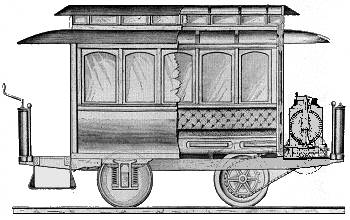 This is a cut-away drawing of Van Depoele's first type of car as used in Scranton, Pennsylvania in 1886, built by Pullman and painted maroon. Note the motor (with chain drive) on the car platform. Similar small cars were used on his early lines such as at South Bend, Indiana; Appleton, Wisconsin; Lima, Ohio; and Montgomery, Alabama. They initially used his "traveler" (sic) current collector.
This is a cut-away drawing of Van Depoele's first type of car as used in Scranton, Pennsylvania in 1886, built by Pullman and painted maroon. Note the motor (with chain drive) on the car platform. Similar small cars were used on his early lines such as at South Bend, Indiana; Appleton, Wisconsin; Lima, Ohio; and Montgomery, Alabama. They initially used his "traveler" (sic) current collector.
So to Charles Joseph Van Depoele. He was born in Belgium in 1846 and was educated at the College at Poperinghe, near the French border. From an early age he was fascinated by electricity and at 15 years of age demonstrated his own electric light design using 40 Bunsen cells. About this time the family moved to Lille in France where he attended the Imperial Lyceum from 1864 to 1869 studying electricity. At this date he left for America and set up in Detroit where he demonstrated various electrical apparatus as well as pursuing more commercial work in woodwork and in the design of arc lamps. In 1874 he was experimenting with dynamos and electric motors for power transmission, when it occurred to him that they could be used to power trains and streetcars. He discussed this with friends and wrote some papers on the subject, but was unable to get any commercial interest or backing.
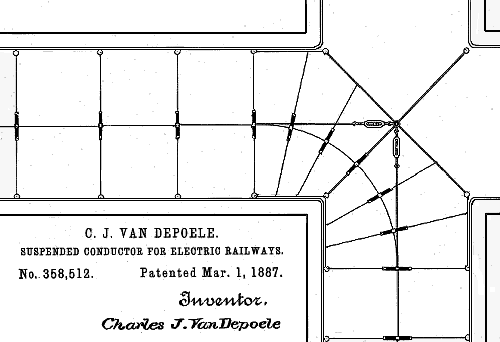
Around 1880 Van Depoele formed the Van Depoele Electric Manufacturing Company, and moved to premises in Chicago to pursue his aspirations. From then on various transport demonstrations were undertaken at these workshops. One in 1882 included the use of an under-running trolley which gave him the precedence over Sprague. In 1883 a 400 ft track was installed with a trolley wire laid at track level in a V shaped trough and raised up by wheels on the car. At the Chicago Inter-state fair, which opened on September 10th 1883, Van Depoele demonstrated a passenger carrying electric car with some form of track level current collection.
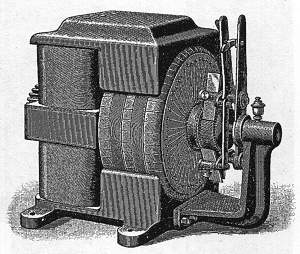 Van Depoele's electric motor was mounted on the front platform of his streetcars and was connected to the leading axle by a chain drive. The handles adjust the brush positions and provide for reversing the car.
Van Depoele's electric motor was mounted on the front platform of his streetcars and was connected to the leading axle by a chain drive. The handles adjust the brush positions and provide for reversing the car.
In July 1884, Van Depoele ran a 1,000 yard line from the entrance to the main building of the Toronto Annual Exposition. This used his open slot conduit system which had an iron edged wooden box between the rails. It contained positive and negative conductor rails which connected with the motor car via two brushes (which in later systems would have been called plows or ploughs - UK), one for each polarity. The motor car had a 30 horsepower (h.p.) motor and pulled three trailers. The generator was 40 h.p. For the 1885 Toronto Annual Exposition Van Depoele returned with a similar but longer line of about a mile from the local railway station to within the exhibition grounds. He used 1,400 volts DC for this and other systems and on this occasion used a trolley with under-running wheel. The cars could travel at 30 mph and on one occasion carried 50,000 passengers in a 5 day period.
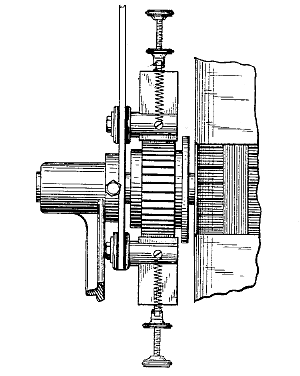 Van Depoele's most significant development was the "Carbon Contact or Commutator-Brush", described in US patent 390,921 of 1888 and shown here as fitted to his traction motor. Prior to this, motors had used thin laminated copper brushes instead of carbon.
Van Depoele's most significant development was the "Carbon Contact or Commutator-Brush", described in US patent 390,921 of 1888 and shown here as fitted to his traction motor. Prior to this, motors had used thin laminated copper brushes instead of carbon.
At this point Charles Van Depoele entered the true streetcar field. Towards the end of 1885 he created his first commercial line, at South Bend, Indiana, proceeding to several other small systems such as Scranton, Pennsylvania which opened in December 1886. These used small cars which were built to horse car designs. A 15 h.p. electric motor, about two feet high and eighteen inches square, was placed on the front platform and was connected to the leading axle by a chain drive. Van Depoele claimed that, "As the motor is placed on the front platform, it is at all times under the eyes of the driver. This enables him to take good care of the machine, and to see that all working parts are in good order. From this point he can also see to the oiling of the shafts". This is possibly the origin of the term "Motorman".
The power was collected from a single copper overhead wire via a small two-wheeled over-running trolley, weighted from below, which Van Depoele liked to call a "traveler". (Note - UK spelling would be "traveller"). It was connected to the car by a flexible cable. To avoid overhead turnouts at passing loops on single track tramways, it was possible for motormen to unplug and exchange "travelers" between cars, although not without some danger of electric shock!
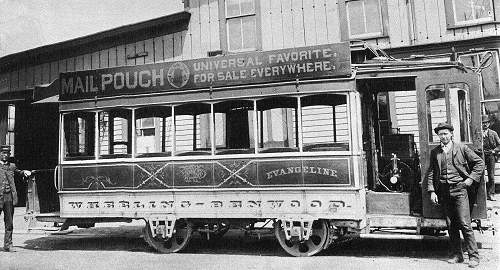
The Van Depoele system was quite happy on gradients. Scranton had twelve grades of 6% and Appleton had grades of 9%. The system at Appleton was also interesting in that it used water power to generate the electricity, as did that at St. Catherines in Canada. Over the winter of 1885/6 he installed a large car with a 50 h.p. motor on the line of the Minneapolis, Lyndale, and Minnetonka Railroad using the same system. This proved most successful in the snow.
By far the most ambitious project was for the Capital City Street Railway Company of Montgomery, Alabama. James A. Gadboury had a controlling interest in this company and had seen Van Depoele's track at the 1885 Toronto exhibition. He met with Van Depoele and invited him to electrify a Montgomery horse line. Service started to run on the Court street line on April 15th 1886. It was such a success that electrification was extended to the other lines, making Montgomery the first place in the world to have a city-wide system of electric transportation. At first Van Depoele's "traveler" overhead was used but later this was replaced by the under-running trolley pole.
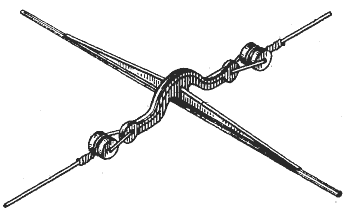 This "Arched Suspender for Overhead Electric Conductors" is an example taken from US patent 393,317 of 1888, and is the type of hanger and ear that was used to support overhead throughout the trolley-pole era.
This "Arched Suspender for Overhead Electric Conductors" is an example taken from US patent 393,317 of 1888, and is the type of hanger and ear that was used to support overhead throughout the trolley-pole era.
The success in Montgomery caused a rush of orders and by 1888 the Van Depoele system in its various forms had been installed in the following places (sizes given where available):-
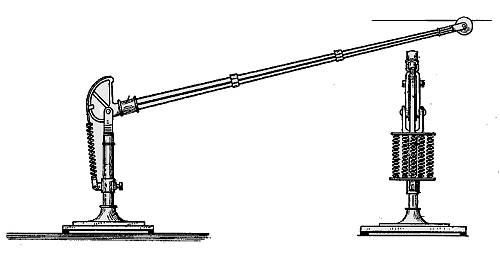
But not all was perfect with the Van Depoele system. As has already been stated the "travelers" were replaced on later systems by trolley poles. The motors on the platforms proved too heavy for the little cars built to horse tram standards and in service the platforms sagged, so larger and stronger cars were tried and ultimately motors were fitted between the axles. The motors themselves were less than perfect with excessive sparking at the brushes. This was solved by Van Depoele by substituting carbon brushes, an invention that he patented (US 390,921 of 1888) and which was to revolutionise the electric motor world.
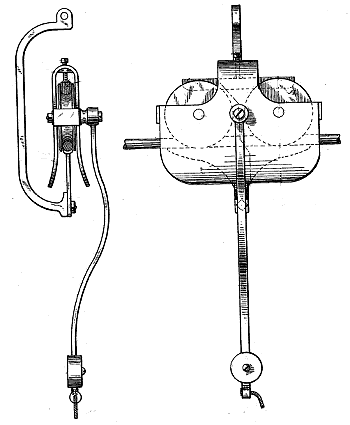 Van Depoele never gave up on his "travelers" as seen here in a late design in US patent 396,310 of 1889, by which date the trolley pole was in widespread use.
Van Depoele never gave up on his "travelers" as seen here in a late design in US patent 396,310 of 1889, by which date the trolley pole was in widespread use.
The trackwork was not perfect either. In common with other early streetcar systems that used the track as a return path for the electric circuit, bad bonding at the rail joints caused problems with electrolysis of the water and gas pipes below, and with interference to telephones which also used an earth return. To improve bonding it was admitted by Elmer Morris, Van Depoele's chief assistant, that they would drive a rail spike into bad joints to make a better contact.
At the end of 1887 Van Depoele's finances were becoming over stretched and with the huge demand for new systems he was under resourced. He considered selling out to the Sprague Electric Railway and Motor Company, but that company was in no position to buy, itself being taken over by Edison General Electric in 1889. Instead the company was sold to the Thomson-Houston Electric Company of Lynn, Massachusetts. This company had been formed by Englishman Professor Elihu Thomson, together with Professor Houston, who he had met when they both had chairs at the Artisans' Night School of Philadelphia. They had perfected very efficient forms of electric motors, generators and electric lighting systems.
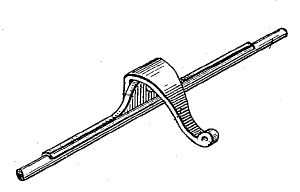 An example of a "Hooked Suspender for Electric Railway Conductors" was extracted from Van Depoele's US patent 396,311 of 1889. This type of pull-off for taking overhead around corners is still in use on tramways today.
An example of a "Hooked Suspender for Electric Railway Conductors" was extracted from Van Depoele's US patent 396,311 of 1889. This type of pull-off for taking overhead around corners is still in use on tramways today.
In mid 1888 Van Depoele moved from Chicago to Lynn, joining the Thomson-Houston Electric Company as an expert and inventor, where he continued to invent and to improve his designs. Thomson-Houston, with the benefit of Van Depoele's patents, then entered the electric tramway field with a vengeance and became a major player. The Thomson-Houston system was installed throughout America and the rest of the world. Système Thomson-Houston was particularly popular in France. In 1892, Edison General Electric was re-organised by J. P. Morgen, dropping the name "Edison", and merging with Thomson-Houston to form the mighty General Electric Company, headed up by Charles A. Coffin, the former boss of Thomson-Houston. Holding both Sprague and Van Depoele patents, it dominated electric traction and still exists today, although as another General Electric Company already existed in the UK, it continued to trade as British Thomson-Houston there.
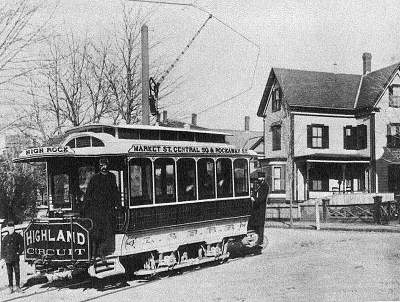 One of the last Van Depoele systems was that at Lynn, Massachusetts where he was working for Thomson-Houston from 1888. Note the use of a trolley pole and overhead pull-offs to the designs in the previous drawings. By then he had also adopted motors fitted between the axles.
One of the last Van Depoele systems was that at Lynn, Massachusetts where he was working for Thomson-Houston from 1888. Note the use of a trolley pole and overhead pull-offs to the designs in the previous drawings. By then he had also adopted motors fitted between the axles.
Throughout his career, Van Depoele was granted in total 243 US patents in his name, over half connected with electric traction. His very first in 1881 was for a "Dynamo-Electric Machine", useful in generating power for his lighting systems and for driving motors. His last, granted posthumously in 1894, describes a gearless electric traction motor mounted on the axle and directly driving the wheels, something years ahead of its time. In between he had covered overhead fittings, travelers, trolley poles, conduit, motors, brush gear, regulators, streetcars, locomotives, lighting, mining equipment and all manner of electrical items. There is a bronze bust of him in the town library of Lynn, Massachusetts and his papers are lodged with the library of the Harvard Business School in Boston.
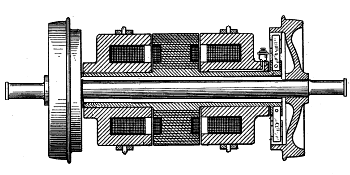 Charles J. Van Depoele's last US patent, 529,671 of 1894 was for a gearless traction motor unit. The field coils surrounded the car axle but did not touch it and were sprung to the truck frame. The revolving armature of the motor was linked by flexible couplings to the inside of the wheels. The patent for this advanced design was granted after Van Depoele's death.
Charles J. Van Depoele's last US patent, 529,671 of 1894 was for a gearless traction motor unit. The field coils surrounded the car axle but did not touch it and were sprung to the truck frame. The revolving armature of the motor was linked by flexible couplings to the inside of the wheels. The patent for this advanced design was granted after Van Depoele's death.
Sadly, unlike Sprague and Daft who both lived into their late 70s, Charles J. Van Depoele was not to see the greatest years of the tramways he helped to create, as quite unknown to his friends he was seriously ill. At Lynn, Massachusetts on 18th March 1892 he died at the age of just 46, leaving a wife and four daughters, Pru, Mae, Adelaide and Matilda.
The main biographical source for this article is Van Depoele's obituary in "Western Electrician" - March 26th 1892. Additional information is from "New England Magazine" Volume VI - 1888, John Anderson Miller's "Fares Please!" - 1941 and Frank Rowsome's "Trolley Car Treasury" - 1956. Some personal facts were supplied by Nancy Van Valkenburgh and Patricia Nolan, Van Depoele's great, great, great, granddaughters. Technical details are from United States patent documents and my thanks go to Bob Appleton for his help in locating these.